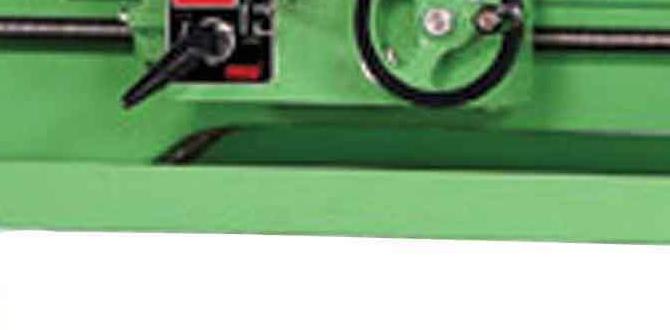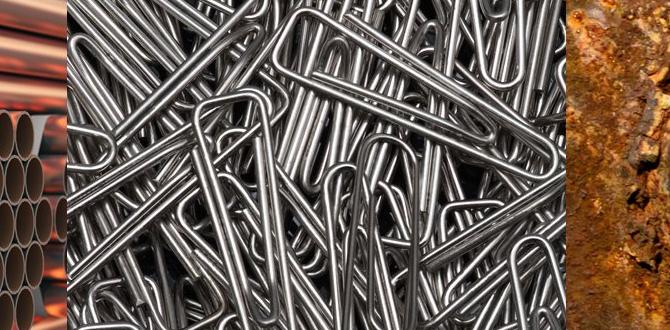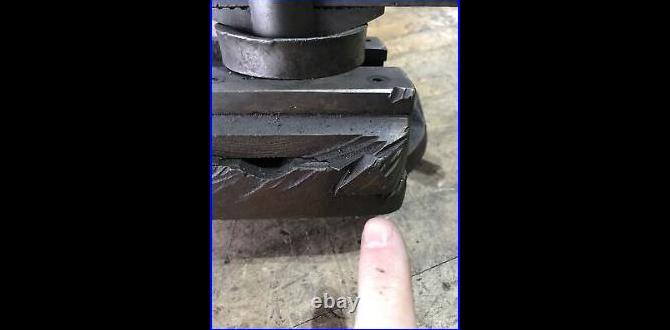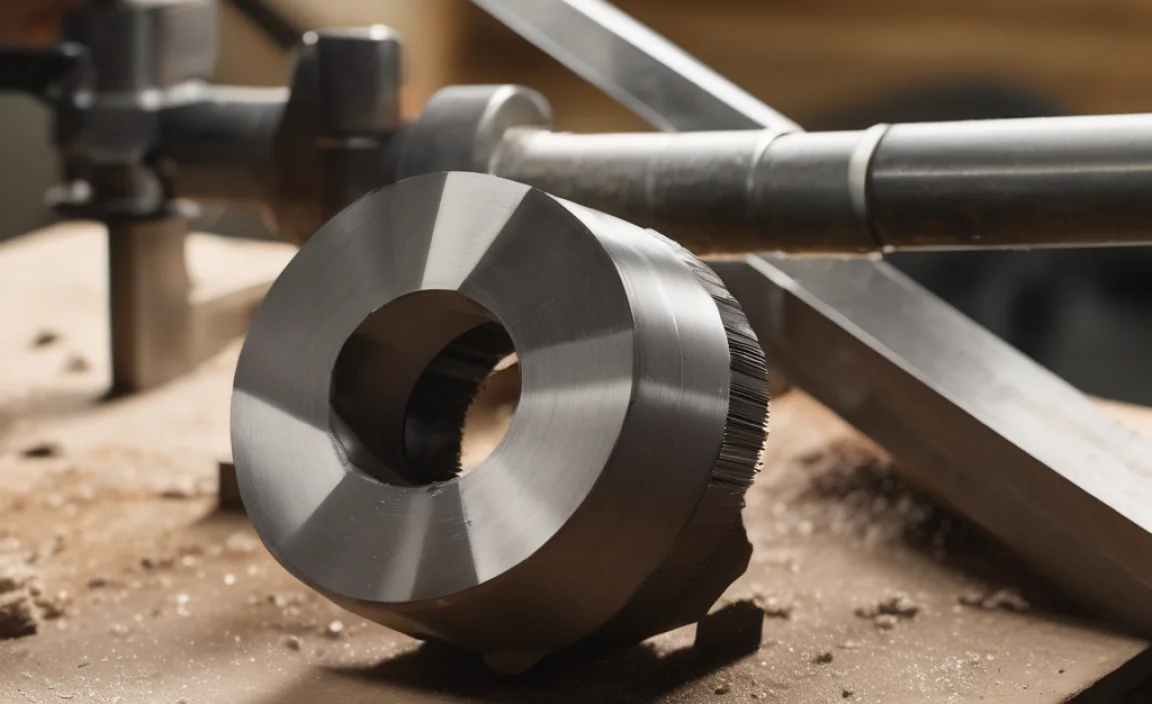Quick Summary: For A2 tool steel, an indexable face mill offers versatility and easy insert changes for flat surfaces, while a shell mill excels at hogging material quickly. Both are valuable, but the best choice depends on your specific machining task and desired finish.
Hey there, makers! Daniel Bates here from Lathe Hub. Ever stared at your A2 tool steel workpiece, wondering which milling cutter will give you the best results without a fight? You’re not alone! Choosing the right tool between an indexable face mill and a shell mill can feel a bit like picking a wrench for a tricky bolt – the wrong one makes the job harder than it needs to be. A2 tool steel is tough stuff, and we want to make sure we’re using the right tools for the job. Don’t worry, we’ll break down exactly what makes each of these cutters tick and help you decide which one is your new best friend for tackling A2. Let’s get those surfaces clean and smooth!
Understanding Your Milling Mission: Why the Right Cutter Matters for A2 Tool Steel
When you’re working with A2 tool steel, you’re dealing with a material known for its excellent hardness, wear resistance, and toughness. These qualities are fantastic for the tools and parts you’ll make, but they also mean it can be challenging to machine. Using the wrong milling cutter can lead to:
- Poor surface finish
- Increased tool wear
- Slow machining times
- Damage to your workpiece or cutter
- Frustration (and nobody wants that in the workshop!)
This is where understanding the difference between two popular types of milling cutters, the indexable face mill and the shell mill, becomes crucial. Both are designed to remove material efficiently, but they do it in slightly different ways and excel in different scenarios, especially when paired with the right inserts for tough materials like A2.
Meet the Contenders: Indexable Face Mill vs. Shell Mill
Let’s get acquainted with our two main players. Think of them as different chefs in your workshop kitchen, each with their own specialty.
The Indexable Face Mill: The Versatile Surface Smoother
An indexable face mill is a versatile tool that typically has a central mounting hole designed to attach to an arbor or a direct mount spindle. Its cutting edges are made up of replaceable “inserts.” These inserts are small, hardened pieces of carbide, ceramic, or even diamond, designed to be indexed (rotated to a fresh edge) or replaced when they become dull. The main body of the mill is often made of steel, designed to hold these inserts rigidly.
Key Features:
- Replaceable Inserts: This is the big one! When an edge wears out, you don’t discard the whole tool. You either rotate the insert to a sharp edge or replace it with a new one.
- Versatile Geometry: Available in many sizes and with different insert geometries to suit various materials and desired surface finishes.
- Excellent for Facing: As the name suggests, they are primarily designed for milling flat surfaces (facing cuts).
- Cost-Effective in the Long Run: While the initial cost might be higher than a solid end mill, the ability to replace inserts makes them economical for frequent use and for harder materials where inserts wear out faster.
- A2 Tool Steel Specifics: For A2 tool steel, you’ll want to ensure you’re using the correct grade of inserts. Cermet or PVD-coated carbide inserts are often recommended for their ability to handle the hardness and heat generated when cutting tool steels. Check out resources like Sandvik Coromant’s guide on machining steel for detailed insert recommendations.
The Shell Mill: The Material Hog
A shell mill is another type of milling cutter, often characterized by a large diameter face and a shank or, more commonly, a large internal hole designed to mount onto a specific adapter (a “shell mill arbor”). Like indexable face mills, shell mills typically use replaceable inserts. However, they are often designed with a more robust construction and aggressive geometries, making them ideal for rapid material removal.
Key Features:
- Designed for Heavy Cuts: Their strong construction and common aggressive tooth profiles make them excellent for taking deeper cuts and removing bulk material quickly.
- Large Diameter Capabilities: Often available in larger diameters, making them perfect for clearing large surface areas efficiently.
- Insert-Based: Also utilizes replaceable inserts, offering the same benefits of cost-effectiveness and ease of maintenance as indexable face mills.
- Specific Arbored Mounting: Requires a dedicated arbor for mounting, which can be a consideration for your machine’s tooling system.
- A2 Tool Steel Application: Ideal for the initial “hogging” stages of machining A2, where you need to quickly remove a significant amount of material before moving to finishing passes.
The Crucial Role of Inserts for A2 Tool Steel
Whether you’re using an indexable face mill or a shell mill, the inserts are where the magic (and the cutting) happens. For A2 tool steel, selecting the right insert material and geometry is paramount:
Common Insert Materials for A2:
- Tungsten Carbide: A workhorse for many machining operations. For A2, look for tougher grades of carbide or those with specific coatings.
- Cermet: These are composite materials made of ceramic and metal. They offer excellent heat resistance and good wear resistance, making them a strong candidate for A2.
- Carbide with PVD Coatings: Physical Vapor Deposition (PVD) coatings, like TiN (Titanium Nitride) or TiAlN (Titanium Aluminum Nitride), add a hard, wear-resistant layer to carbide inserts, significantly extending their life and improving performance on tough materials.
- Ceramics: Can be used for very high-speed machining of hardened steels, but can be brittle, so careful setup is required.
Key Considerations for Insert Selection:
- Edge Strength: You need an insert that can withstand the forces involved without chipping.
- Heat Dissipation: A2 generates heat. The insert material and coatings should help manage this.
- Surface Finish Requirements: Finer geometries and polished edges on inserts yield smoother finishes, which might be necessary for your A2 project.
- Manufacturer Recommendations: Always consult the insert manufacturer’s data for material compatibility. Companies like Iscar, Kennametal, and Seco Tools provide excellent specifications and recommendations.
When to Use Which: Making Your Decision
The choice between an indexable face mill and a shell mill for A2 tool steel is often dictated by the specific task:
Indexable Face Mill Scenarios:
- Achieving a Flat, Smooth Finish: If your primary goal is to create a perfectly flat and smooth surface, especially for precision parts.
- Versatility on Different Surfaces: When you need a tool that can handle various depths of cut and surface requirements.
- Ease of Setup on Standard Spindles: They often mount directly or on a common arbor, fitting a wider range of milling machine setups.
- Controlled Material Removal: When you want to remove material in a more measured way, focusing on accuracy.
- Replacing Solid Cutters: As a more economical and durable alternative to solid carbide or HSS face mills for A2.
Shell Mill Scenarios:
- Rapid Material Bulk Removal: When you need to quickly rough out a large surface area or remove a significant amount of material.
- Machining Large Workpieces: For applications where a larger diameter cutter can cover the surface area much faster.
- Heavy-Duty Roughing Operations: When the machine and setup can handle aggressive, deep cuts.
- When a Robust Setup is Available: Shell mills often require a specific, strong arbor system.
Technical Comparison: What Sets Them Apart?
Let’s put them side-by-side in a table to highlight their differences when machining A2 tool steel.
| Feature | Indexable Face Mill | Shell Mill |
|---|---|---|
| Primary Use | Facing, precise surface finishing, general milling | Heavy roughing, large surface area removal |
| Mounting | Arbor mount, direct spindle mount (e.g., CAT, BT, HSK) | Typically mounts to a specific shell mill arbor |
| Typical Diameter Range | 2″ to 12″+ (common for hobbyists: 2″ to 6″) | 3″ to 24″+ (common for hobbyists: 3″ to 8″) |
| Insert Options | Wide variety: general purpose, high-feed, high-positive rake, etc. | Often focused on robust, high-positive or neutral rake inserts for heavy cuts. |
| Axial Depth of Cut (DOC) | Generally moderate, can be shallow for finishing. | Capable of deeper DOC, especially for roughing. |
| Radial Depth of Cut (Width of Cut) | Can be set for full face or partial width. | Often used for full-width cuts or very large portions of surfaces. |
| Edge Cost | Moderate to high per insert, but long-term cost is often lower due to indexing. | Similar to face mills; cost per insert, but economical due to replaceability. |
| Ideal for A2 Roughing | Yes, with appropriate inserts. | Excellent, designed for aggressive material removal. |
| Ideal for A2 Finishing | Excellent, with fine-finish or high-precision inserts. | Less common for fine finishing; usually followed by a finishing tool. |
Practical Steps for Machining A2 Tool Steel Safely
No matter which mill you choose, safe and effective machining of A2 tool steel requires careful attention to detail. Here’s a general approach:
-
Preparation is Key:
- Secure the Workpiece: Ensure your A2 workpiece is clamped down extremely securely. Sudden tool engagement can move or eject material. Use workholding that can handle the significant forces of milling.
- Machine Condition: Make sure your milling machine is in good condition. A rigid machine with no backlash is vital for predictable results.
- Cleanliness: Remove any chips or debris from the machine and your work area.
-
Tool and Insert Selection:
- Refer to the table and scenarios above.
- Select inserts specifically rated for steels like A2. Consult manufacturer guides for best practices. For example, Seco Tools offers extensive data on carbide insert selection for various materials.
- Ensure your chosen inserts are correctly seated and tightened in the mill.
-
Setting Up the Cut:
Spindle Speed (RPM) and Feed Rate (IPM/mm/min): This is probably the most critical part for A2.
- Start Conservatively: Hard steels require lower speeds and moderate feeds compared to softer materials like aluminum.
- Calculate Machining Parameters: Use the cutting speed (SFM or m/min) recommended by your insert manufacturer for A2 tool steel and your insert’s effective diameter to calculate RPM:
RPM = (Cutting Speed × 12) / (π × Diameter)
- Feed Per Tooth (FPT): This is crucial for chip control. A good starting point for A2 with carbide inserts might be around 0.004″ – 0.008″ (0.1 – 0.2 mm) per tooth. Adjust based on chip formation.
- Depth of Cut (DOC): For roughing, you might take 0.100″ – 0.250″ (2.5 – 6 mm) or more with a shell mill, within the limits of your machine and cutter. For finishing with a face mill, this would be much shallower, perhaps 0.010″ – 0.050″ (0.25 – 1.25 mm).
- Monitor chip thinness and color. Thin, light blue chips are good. Gummy, dark chips indicate issues.
-
Machining Process:
- Coolant/Lubrication: For A2, using a good quality cutting fluid (soluble oil or synthetic) is highly recommended. It helps lubricate, cool, and flush chips away, extending tool life and improving the surface finish. Flood coolant is generally best for this type of work.
- Engage the Cut Smoothly: Avoid plunging directly into the material. Approach at an appropriate feed rate or ramp into the cut if your machine and programming allow.
- Listen to the Machine: Changes in the cutting sound can indicate a problem (e.g., dulling insert, chatter, overload).
- Chip Evacuation: Ensure chips are being cleared effectively. Poor chip evacuation can lead to chip recutting and tool damage, especially with hard steels.
-
Inspection and Adjustment:
- Periodically stop the machine to inspect the workpiece for surface finish and dimensions.
- Check the inserts for signs of wear, chipping, or built-up edge. If wear is uniform, considering indexing or changing the inserts.
Safety is always the top priority. Wear appropriate safety glasses and hearing protection. Always ensure your workpiece and tooling are securely fastened before starting any machining operation.
Choosing Inserts for A2: A Deeper Dive
Let’s consider some common classifications and what they mean for A2 machining:
Insert Geometries
The geometric features of an insert, especially its cutting edge, significantly impact performance. For A2:
- Positive Rake: These inserts have a sharper cutting edge angle, reducing cutting forces and heat. They are excellent for softer materials and can be used for finishing or general-purpose milling of A2, often with PVD-coated carbide or cermets.
- Neutral or Negative Rake: These geometries are stronger and better for heavy roughing. They can handle more aggressive cuts but generate more heat and require more power. They are often made of tougher grades of carbide or ceramics.
- Chip Breakers: Many inserts have specialized chip-breaker grooves to help create smaller, manageable chips. This is crucial for A2 to prevent jamming and ensure good surface finish.
Coating Technologies
Coatings are thin, hard layers applied to the insert surface. For A2, these are critical:
- PVD (Physical Vapor Deposition): Applied at lower temperatures. TiN, TiCN, and AlTiN are common. AlTiN is particularly good for steels and high-temperature alloys as it forms an aluminum oxide layer under heat, providing extra hardness.
- CVD (Chemical Vapor Deposition): Applied at much higher temperatures. Various carbide and nitride layers are used. TiC (Titanium Carbide) and TiCN (Titanium Carbonitride) are standard.
- Ceramic Coatings: Often multi-layered and designed for high-speed machining of heat-resistant materials, but can be brittle.
A good starting point for A2 is often a PVD-coated carbide insert, possibly a cermet, with a geometry suitable for your specific cut. Always check the manufacturer’s catalog for application charts. For instance, Kennametal’s product catalog details specific insert grades and geometries for machining steels.
When to Index or Replace Inserts
Knowing when to tend to your inserts is key to avoiding problems:
- Visual Inspection: Look for wear flats on the flank face, chipping on the cutting edge, or signs of material buildup.
- Surface Finish Degradation: If the finish on your workpiece starts to get rougher or shows signs of tearing.
- Increased Cutting Forces: If the machine sounds like it’s straining more than usual, or if chatter develops.
- Dimension Deviations: If your parts are no longer coming to size.
For indexable mills, if an insert has multiple cutting edges, rotate it to a fresh edge. Once all edges are worn, replace the insert. For shell mills, it’s








